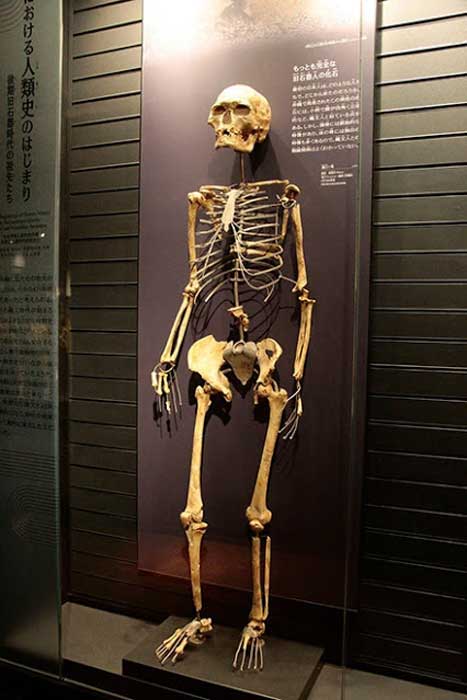
Did Japanese Population Originate with this Minatogawa Man?
A new scientific report published in Nature has concluded that the modern Japanese descended from the Minatogawa people of the Paleolithic era. This is based on a DNA study of a 20,000-year-old human, codenamed Minatogawa 1, who was discovered in a limestone quarry in the Japanese Okinawa Prefecture back in 1970.

Replica of the Minatogawa man’s skeleton with DNA ties to modern Japanese population. (National Museum of Nature and Science, Tokyo)
The Origins of Modern Human Japanese Population
Paleoanthropologists have long assumed that modern man (Homo sapiens) first migrated east out of Africa and into modern-day China about 50,000 BC. The popular belief is that the first humans on the Japanese Archipelago migrated from somewhere in southeast Asia. According to human migration models and archaeological evidence, people first reached Japan in the late Pleistocene, around 40,000 or 30,000 years ago, at a time when the archipelago was connected to the Asian continent.
- 9,000-Year-Old Human Remains May Shed Light On Prehistoric Okinawa
- Five Bold Navigators Master the Deadly ‘Black Stream’ Migration After 32,000 Years
The frequently told story of human history in Japan claims that the modern-day Japanese descended from two different groups of migrants. These were the historic ancestors of the Jomon people, hunter-gatherers who existed between 14,500 BC and 1,000 BC. Later they were followed by a second wave of farming human migrants from Northeast Asia known as the Yayoi who existed between 1,000 BC and 250 AD. Both cultures have been identified due to their distinctive pottery styles.

Forensic reconstruction and skull of a Jomon person in Japan. (inazakira / CC BY-SA 2.0)
Discovery of the Minatogawa
In the late 1960s, amateur archaeologist Seiho Oyama purchased a series of stone blocks in which he observed fossilized bone fragments within. This unexpected discovery led to his near obsession with the Minatogawa quarry in the Okinawa Prefecture, on the Japanese Ryukyu Islands, from where they had been sourced. In 1968 Oyama reported the discovery of human remains to a Tokyo University professor who then proceeded to excavate the site up until 1974.
Digs at the site took place in a 1-meter-wide (3.28 ft) exposed fissure at the quarry. Archaeologists unearthed bone fragments belonging to between 5 and 9 individual skeletons, which they named the Minatogawa people. The Tokyo University professor who led the excavations, Hisashi Suzuki, argued that these Paleolithic individuals had been killed by arrows or spears and were then cannibalized.
The males were about 1.55 meters tall (5 ft) while the women were about 1.4 meters (4.6 ft) tall. “Narrow-shouldered, they had a sturdy lower-body skeletal build, which experts believe made them suited to running on barren land,” explains Archaeology News Network. Minatogawa 1 is the name given to a complete skeleton found at the site, a replica of which is now on display at the Tokyo University Anthropology Museum.
This discovery was very exciting for Japanese archaeology, due to the lack of skeletal remains and DNA unearthed to date on the islands. This is caused by the acidic soil composed of volcanic ash which creates “an environment which is detrimental to the preservation of ancient biomolecules,” explains the report in Nature. The 20,000-year-old remains discovered at the Okinawa quarry “are amongst the few Paleolithic humans whose remains have so far been discovered in Japan,” explains Archaeology News Network.

Reconstruction on display of a Minatogawa man in Japan.(Tsunagaru Map)
Science Uncovers New Links to Explain the Origins of Japanese Population
Nevertheless, after the excitement subsided researchers were unable to uncover the link between these Minatogawa peoples and the story of human history in Japan as evidenced in the rest of the archaeological record. Were these Minatogawa peoples the ancestors for the Jomon? Had the Minatogawa died out? Or had they simply emigrated somewhere else at some point in ancient history?
Due to a lack of evidence to prove any direct connection, Archaeology News Network highlights that “the issue had remained moot, not least because the facial skeleton of the Minatogawa people bore little resemblance to Jomon people.” That is until a group of researchers from a selection of institutions, including the Graduate University for Advanced Studies and Toho University, came together to look at mitochondrial DNA.
Minatogawa 1, the male Paleolithic human found at the quarry, became the focus of the study after the team managed to extract a complete mitogenome sequence. Their hope was to trace the human origins of Japanese population further back than the Jomon. To understand why this was an important breakthrough, “Mitochondrial DNA is passed down from mothers to their children and contains region-specific vestiges due to mutations, which allows origins of populations to be traced,” highlights Archaeology News Network.
- Here’s How Genetics Helped Crack the History of Human Migration
- Surprise Discovery of 45,000-Year-Old Tools in Mongolia Indicates Early Human Migration
Through analysis of Minatogawa 1’s DNA, the team were able to identify a component common to the Jomon, the Yayoi and modern Japanese humans. While an analysis of about 2,000 modern-day members of the Japanese population did not find any direct descendants, that doesn’t rule out the possibility that Minatogawa direct ancestors will not be discovered in future studies.
In a nutshell, this means that the “modern Japanese likely have distant ancestral ties with Minatogawa people.” Nevertheless, to truly decipher the human history of Japanese populations, archaeology will need to keep digging to find more Paleolithic bones and do more tests on existing human remains. The lead author of the study, Jun Gojobori, stressed that they “hope to study the bones of more Paleolithic people to better understand the origins of the Japanese.”
Top image: The Japanese population is descended from the Minatogawa man, depicted here in an artistic reconstruction. Source: Teruya Yamamoto / National Museum of Nature and Science, Tokyo
By Cecilia Bogaard















